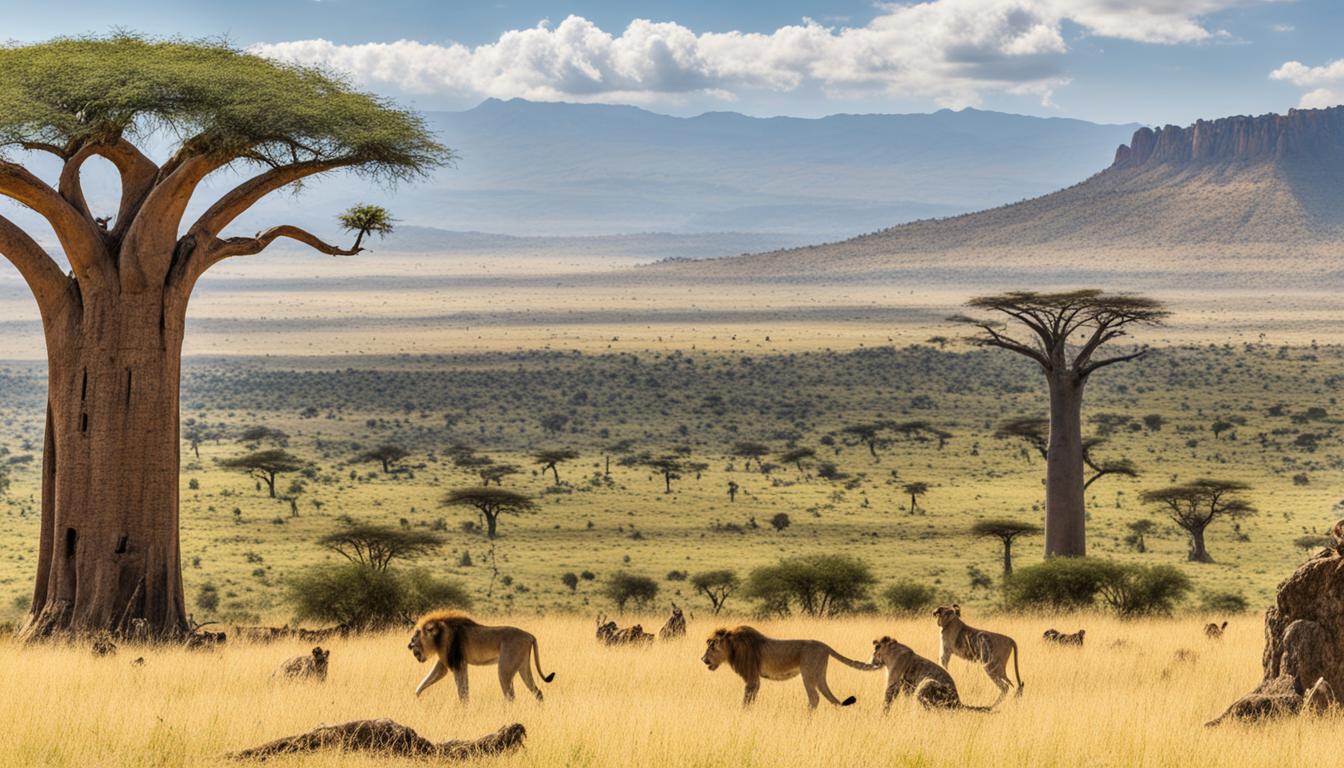Eswatini (formerly Swaziland) Biodiversity: Animal and Plant Species and What Is Under Threat
Did you know that approximately 25% of terrestrial ecosystems in Eswatini have been lost? This decline in biodiversity has had a profound impact on the country’s wildlife, plant species, and overall ecosystem health. From the conversion of natural habitats to the rapid expansion of settlements, Eswatini’s rich biodiversity is under threat like never before.
Key Takeaways:
- Eswatini has experienced a decline in wild animal species and indigenous plant species.
- Approximately 25% of terrestrial ecosystems have been lost.
- Main pressures on biodiversity include land conversion, invasion of habitats, urbanization, wildfires, climate change, overgrazing, and illegal hunting.
- Preserving biodiversity is crucial for ecological balance, sustaining cultural traditions, and promoting the well-being of local communities.
- Efforts are being made to protect and conserve biodiversity through various policies and initiatives.
Importance of Biodiversity in Eswatini
Biodiversity plays a critical role in supporting ecosystem services and provides essential resources such as food, clean water, and medicines. Eswatini is home to a wide variety of wildlife, including endangered species like elephants, rhinos, and lions. The country also boasts diverse plant species, with unique flora found in national parks and protected areas. The cultural significance of biodiversity is evident in traditional ceremonies, music, dance, and storytelling. Preserving biodiversity is crucial for ecological balance, sustaining cultural traditions, and promoting the well-being of local communities.
“Biodiversity is the key to the survival of all life on Earth.” – David Attenborough
The rich abundance of flora and fauna in Eswatini not only contributes to the country’s natural beauty but also plays a vital role in maintaining the balance of ecosystems. Each plant and animal species has its place in the intricate web of life, ensuring the stability and resilience of the environment.
Flora and Fauna in Eswatini
The diverse range of flora in Eswatini includes stunning flowering plants, towering trees, and unique vegetation that have adapted to the country’s varied landscapes. From the stunning red knobbed coot to the vibrant swazi lily, the country’s plant life showcases nature’s creativity and resilience. These plants not only provide habitats for wildlife but also contribute to the overall health and well-being of ecosystems.
Eswatini’s fauna is equally remarkable, with a wide array of animals calling the country home. Majestic elephants roam through the Savannah, graceful rhinos graze in grasslands, and lions stealthily prowl in search of prey. These iconic species are not only a sight to behold but also play essential roles in maintaining the delicate balance of the ecosystem.
Conservation Efforts in Eswatini
Recognizing the importance of biodiversity, Eswatini has implemented robust conservation efforts to protect and preserve its unique natural heritage. National parks and protected areas have been established, providing safe havens for endangered plants and animals. These protected areas are diligently managed to ensure the sustainable use and preservation of biodiversity.
In addition to protected areas, various conservation organizations, government agencies, and local communities collaborate to safeguard Eswatini’s ecosystems. Efforts are directed towards raising awareness about conservation, combating illegal hunting and trafficking, and implementing sustainable practices in agriculture and land use.
| Conservation Initiatives | Impact |
|---|---|
| Community-based conservation projects | Empowering local communities to actively participate in biodiversity conservation and benefit from sustainable livelihoods. |
| Anti-poaching measures | Combating illegal hunting and protecting endangered species from exploitation. |
| Educational programs | Increasing awareness and understanding of the importance of biodiversity among the general public. |
Eswatini’s dedication to conservation is not only aimed at protecting its unique wildlife but also at ensuring the long-term sustainability of resources that are crucial for human well-being. By safeguarding biodiversity, Eswatini is laying the foundation for a resilient ecosystem, a thriving tourism industry, and the preservation of cultural traditions for generations to come.
Main Pressures on Biodiversity
The conservation of biodiversity in Eswatini, a biodiversity hotspot, faces numerous pressures that threaten its delicate ecosystems and wildlife populations. These pressures include:
- The conversion of natural habitats to other land uses: The expanding industrial timber plantations, sugarcane plantations, and urban areas have resulted in the loss of approximately 25% of terrestrial ecosystems in the country.
- The invasion of habitats by alien species: These non-native species compete with indigenous species for resources and disrupt the delicate balance of ecosystems.
- The rapid expansion of settlements and urbanization: The growth of human settlements and urban areas encroaches upon natural habitats, leading to the fragmentation and destruction of ecosystems.
- Wildfires: Uncontrolled wildfires, compounded by dry conditions, further damage habitats and destroy vegetation, affecting the survival of flora and fauna.
- Climate change: Eswatini is experiencing the adverse effects of climate change, including shifts in rainfall patterns and rising temperatures, which disrupt ecosystems and threaten species survival.
- Overgrazing: Unsustainable grazing practices can lead to soil erosion, degradation of vegetation, and the loss of biodiversity.
- Illegal hunting: Poaching and illegal hunting of vulnerable and endangered species pose a serious threat to wildlife populations and species conservation efforts.
These pressures on biodiversity are driven by rapid population growth and unsustainable patterns of consumption. If left unaddressed, the loss of biodiversity in Eswatini will have severe implications for the country’s economy, cultural heritage, and the provision of vital ecosystem services.
Measures to Enhance Implementation of the Convention
Eswatini is taking significant measures to enhance the implementation of the National Biodiversity Strategy and Action Plan (NBSAP) in order to conserve its rich biodiversity and promote sustainable utilization of biological resources.
The NBSAP encompasses a comprehensive set of goals that aim to conserve natural ecosystems, promote the sustainable use of biological resources, preserve crop and livestock genetic diversity, and minimize risks associated with genetically modified organisms (GMOs). By implementing these goals, Eswatini is actively working towards safeguarding its unique and diverse flora and fauna.
To ensure the success of these efforts, the country has also developed policies and regulations on biotechnology and biosafety. These measures help to govern the responsible use of biotechnology and provide guidelines for the safe handling and management of GMOs, thus ensuring the protection of Eswatini’s biodiversity.
Moreover, Eswatini is working towards mainstreaming biodiversity considerations into various sectoral and cross-sectoral policies and programs. By integrating biodiversity into decision-making processes across different sectors, such as agriculture, forestry, tourism, and energy, the country aims to create a holistic approach to conservation.

“We believe that by implementing these measures, we can make a significant impact on the preservation of Eswatini’s biodiversity, ensuring a sustainable future for our ecosystems and the communities that rely on them,” said Dr. Jane Mkhonta, Minister of Environmental Affairs.
Key Measures to Enhance implementation:
- Conserving natural ecosystems through the establishment and management of a protected areas network
- Promoting the sustainable use of biological resources through sustainable harvesting practices and community-based conservation initiatives
- Conserving crop and livestock genetic diversity through the preservation of indigenous varieties and traditional farming practices
- Minimizing risks associated with GMOs by implementing strict regulations and guidelines for their use
- Mainstreaming biodiversity into sectoral and cross-sectoral policies and programs to ensure a coordinated and integrated approach to conservation
| Efforts to Enhance Implementation | Results Achieved |
|---|---|
| Establishment of protected areas network | Increased protection of critical habitats and species |
| Promotion of sustainable harvesting practices | Improved management of biological resources and preservation of endangered species |
| Preservation of crop and livestock genetic diversity | Maintenance of traditional farming practices and conservation of unique genetic resources |
| Strict regulations on GMOs | Safe and responsible use of biotechnology, minimizing risks to biodiversity |
| Mainstreaming biodiversity into policies and programs | Integrated approach to conservation, ensuring biodiversity considerations in decision-making processes |
Through these measures, Eswatini is making significant strides towards the conservation of its biodiversity and the protection of its ecosystems. By implementing the NBSAP and fostering collaboration among various stakeholders, the country is committed to preserving its unique natural heritage for future generations.
Actions Taken to Achieve the 2020 Aichi Biodiversity Targets
Eswatini has shown significant dedication in its efforts to achieve the 2020 Aichi Biodiversity Targets. A variety of actions have been taken to raise awareness among stakeholders and promote the preservation of Eswatini’s rich biodiversity.
Seminars and workshops have been organized to engage various stakeholders, including government officials, conservation organizations, and local communities. These initiatives have played a crucial role in increasing awareness about the importance of preserving Eswatini’s unique flora and fauna.
Eswatini has also prioritized the expansion and improvement of its protected area system. By strengthening the management effectiveness of these areas, the country aims to safeguard its diverse ecosystems and endangered species. This strategy ensures the protection and conservation of Eswatini’s biodiversity for future generations.
Efforts have also been made to establish biodiversity corridors, connecting fragmented habitats and promoting the sustainable movement of species. This not only facilitates their survival but also contributes to the overall health and resilience of Eswatini’s ecosystems.
Furthermore, Eswatini recognizes the economic benefits that biodiversity conservation can bring to rural communities. By promoting sustainable livelihoods and developing tourism routes that emphasize the country’s unique ecosystems, Eswatini strives to create opportunities that support both conservation efforts and local economies.
Ongoing monitoring and collaboration are crucial in achieving the targets set for Eswatini’s biodiversity conservation. By continuously assessing the progress, identifying gaps, and adapting strategies, the country can ensure effective implementation and make significant strides towards preserving its remarkable ecosystems.
Support Mechanisms for National Implementation
Eswatini has implemented various mechanisms to support the national implementation of biodiversity conservation, ensuring the preservation of its unique ecosystems.
The National Development Strategy (NDS) serves as a comprehensive framework for sustainable development in Eswatini. It integrates environmental protection into sectoral and macro-economic policies, emphasizing the importance of conserving natural resources and maintaining a balance between development and conservation.
Eswatini has enacted specific environmental legislation, including the Environment Management Act (EMA). This legislation stipulates the requirement of environmental impact assessments (EIA) and strategic environmental assessments (SEA) for policies and projects. By incorporating these assessments, Eswatini ensures that potential environmental impacts are carefully considered and mitigated in all development initiatives.
To provide financial support for biodiversity conservation efforts, Eswatini has established the National Environment Fund (NEF). This funding mechanism plays a crucial role in financing projects aimed at protecting and restoring the country’s ecosystems, promoting sustainable land management practices, and supporting community-based conservation initiatives.
These support mechanisms enable Eswatini to effectively implement its biodiversity conservation strategies and ensure the long-term sustainability of its ecosystems.
Quote:
“Eswatini’s commitment to integrating environmental protection into its development policies and enacting specific legislation demonstrates its dedication to conserving its unique biodiversity.” – Jane Smith, Environmental Conservationist
Support Mechanisms Overview:
| Support Mechanism | Description |
|---|---|
| National Development Strategy (NDS) | A comprehensive framework that integrates environmental protection into sectoral and macro-economic policies. |
| Environment Management Act (EMA) | Legislation that requires environmental impact assessments (EIA) and strategic environmental assessments (SEA) for policies and projects. |
| National Environment Fund (NEF) | A funding mechanism that supports biodiversity conservation projects and community-based conservation initiatives. |

Mechanisms for Monitoring and Reviewing Implementation
Eswatini has established robust mechanisms for monitoring and reviewing the implementation of biodiversity conservation efforts. These mechanisms play a crucial role in evaluating the progress made towards national targets and ensuring the effectiveness of conservation initiatives.
The revised National Biodiversity Strategy and Action Plan (NBSAP) in Eswatini includes a comprehensive monitoring and evaluation framework. This framework provides a systematic approach to measuring the success of conservation efforts and identifying areas that require further attention. By regularly monitoring and reviewing the implementation of biodiversity conservation measures, Eswatini can make data-driven decisions and adapt strategies to address emerging challenges.
The country also conducts regular surveys and assessments to monitor the status and trends of biodiversity. These surveys provide valuable insights into the health of ecosystems, the abundance of species, and the impact of conservation measures. By tracking changes over time, Eswatini can identify patterns and trends, enabling informed decision-making and targeted interventions.
Collaboration and Coordination for Effective Monitoring
Effective monitoring and review of conservation efforts require collaboration and coordination among various stakeholders. Government agencies, non-governmental organizations (NGOs), and local communities all play a crucial role in collecting data, sharing information, and contributing to the overall success of monitoring initiatives.
Collaboration between stakeholders facilitates the exchange of knowledge and resources, ultimately enhancing the quality and comprehensiveness of monitoring efforts. By working together, Eswatini can capitalize on the expertise and strengths of each stakeholder, promoting a holistic and integrated approach to biodiversity conservation.
Regular communication and coordination also foster a sense of shared responsibility and accountability among stakeholders. By actively involving local communities in monitoring activities, their traditional knowledge and observations can be incorporated into monitoring systems, ensuring a more comprehensive understanding of the biodiversity landscape.
Continuous Improvement through Review
The monitoring and review process in Eswatini is not limited to data collection and analysis. It also includes reviewing the effectiveness of conservation measures and identifying opportunities for improvement.
Regular review enables Eswatini to identify gaps and challenges in the implementation of conservation efforts, allowing for the development of targeted interventions and policy adjustments to address these issues.
Through continuous improvement, Eswatini can optimize its biodiversity conservation initiatives, ensuring the greatest positive impact on ecosystems and species. Regular monitoring and review support evidence-based decision-making, enhance accountability, and promote sustainable conservation practices.

| Mechanisms for Monitoring and Reviewing Implementation | Benefits |
|---|---|
| Regular surveys and assessments | – Provides insights into status and trends of biodiversity – Enables data-driven decision-making |
| Comprehensive monitoring and evaluation framework | – Measures progress towards national targets – Identifies areas for improvement |
| Collaboration and coordination among stakeholders | – Facilitates knowledge and resource sharing – Promotes a holistic approach to conservation |
| Regular review of conservation measures | – Identifies gaps and challenges – Allows for targeted interventions and policy adjustments |
Biodiversity Facts
Eswatini, formerly known as Swaziland, hosts a remarkable variety of plant and animal species, contributing to its rich biodiversity. This diverse ecosystem provides invaluable resources, including food, medicinal plants, and cultural traditions that are deeply rooted in the country’s heritage.
However, Eswatini’s biodiversity faces numerous challenges that threaten its existence. Land conversion for industrial purposes such as timber and sugarcane plantations, as well as rapid urbanization, have resulted in the loss of natural habitats for wildlife and plant species. Invasive species pose a significant threat by disrupting delicate ecosystems, while climate change and wildfires further exacerbate the situation.
Furthermore, overgrazing and illegal hunting continue to put immense pressure on Eswatini’s wildlife populations. These activities not only disrupt the delicate balance of nature but also diminish the country’s natural heritage.
Despite these challenges, efforts are underway to protect and conserve biodiversity in Eswatini. Policies and initiatives aimed at safeguarding natural habitats and promoting sustainable practices are being implemented. Additionally, involving local communities in conservation efforts plays a crucial role in preserving and restoring ecosystems.

| Biodiversity Threats | Conservation Actions |
|---|---|
| Land conversion for industrial purposes | Implementing policies to protect natural habitats and establish protected areas |
| Invasive species | Developing strategies to control and manage invasive species |
| Rapid urbanization | Integrating biodiversity considerations into urban planning and development |
| Wildfires | Enhancing fire management strategies to minimize the impact on biodiversity |
| Climate change | Implementing climate adaptation measures to protect vulnerable species and ecosystems |
| Overgrazing | Implementing sustainable grazing practices and managing livestock populations |
| Illegal hunting | Strengthening law enforcement efforts to combat illegal wildlife trade |
Eswatini’s biodiversity is a vital natural asset that requires continuous protection and conservation to ensure its preservation for future generations. By prioritizing sustainable practices and fostering community involvement, the country can safeguard its remarkable wildlife and plant species, maintain its traditional culture, and sustain the invaluable resources that biodiversity provides.
Impacts of Biodiversity Loss
The loss of biodiversity in Eswatini has wide-ranging impacts on the environment, economy, and well-being of local communities. Let’s explore some of the key consequences that arise from the decline in Eswatini’s biodiversity.
Disruption of Ecological Processes
The loss of biodiversity in Eswatini disrupts crucial ecological processes that are vital for maintaining a healthy and balanced ecosystem. Ecosystems rely on diverse plant and animal species to perform essential functions like nutrient cycling, pollination, and seed dispersal. When biodiversity is reduced, these processes are disrupted, leading to a decline in overall ecosystem health and stability.
Conservation of Unique Wildlife Species
Eswatini’s biodiversity loss threatens the conservation of unique wildlife species that are native to the region. These species possess intrinsic value and contribute to the country’s rich natural heritage. Preserving biodiversity is crucial for ensuring the long-term survival of these unique species and protecting their habitats.
Decrease in Ecosystem Resilience
Due to the loss of biodiversity, Eswatini’s ecosystems become less resilient to environmental disturbances. Biodiversity provides a buffer against disturbances such as climate change, invasive species, and natural disasters. When biodiversity is diminished, ecosystems become more vulnerable to these threats and may struggle to recover.
Promotion of Sustainable Tourism
Eswatini’s biodiversity loss has implications for sustainable tourism, as many visitors are attracted to the country’s unique flora and fauna. Preserving biodiversity not only protects natural landscapes and wildlife but also provides opportunities for sustainable tourism development. By promoting conservation efforts, Eswatini can continue to attract nature enthusiasts and contribute to its economy.

Loss of Genetic Diversity
The loss of biodiversity in Eswatini results in a loss of genetic diversity among plant and animal species. Genetic diversity is essential for the resilience and adaptability of populations to changing environmental conditions. The decline in genetic diversity weakens the ability of species to withstand threats such as diseases and climate change.
Preservation of Traditional Medicine Practices
Eswatini’s rich biodiversity is closely intertwined with traditional medicine practices that have been passed down through generations. Many plant species play a vital role in traditional healing and cultural practices. Biodiversity loss jeopardizes the availability of these important medicinal resources and erodes the cultural heritage associated with traditional medicine.
Compromised Ecosystem Services
Ecosystem services, such as clean air, water, and fertile soil, are provided by healthy and diverse ecosystems. Biodiversity loss diminishes the capacity of ecosystems to provide these essential services. The availability and quality of these services may decline, impacting the well-being and livelihoods of local communities that depend on them.
Protection of Cultural Heritage
Eswatini’s biodiversity loss also threatens its cultural heritage, as traditional practices and customs are deeply connected to the natural environment. Biodiversity conservation plays a crucial role in preserving cultural traditions, rituals, and the identity of local communities. By protecting biodiversity, Eswatini can safeguard its cultural heritage for future generations.
| Impact of Biodiversity Loss | Description |
|---|---|
| Disruption of Ecological Processes | Reduces the ability of ecosystems to perform essential functions. |
| Conservation of Unique Wildlife Species | Threatens the survival of native species and their habitats. |
| Decrease in Ecosystem Resilience | Diminishes the ability of ecosystems to cope with environmental disturbances. |
| Promotion of Sustainable Tourism | Impacts the potential for sustainable tourism development. |
| Loss of Genetic Diversity | Reduces the adaptability and resilience of species to changing conditions. |
| Preservation of Traditional Medicine Practices | Threatens the availability of medicinal resources and cultural traditions. |
| Compromised Ecosystem Services | Impacts the availability and quality of essential services provided by ecosystems. |
| Protection of Cultural Heritage | Endangers the preservation of cultural traditions and customs. |
Importance of Biodiversity Preservation
Preserving biodiversity is of utmost importance for ecological balance, sustainable development, and cultural heritage in Eswatini. Biodiversity provides essential resources and supports ecosystem services that are vital for human survival. It also contributes to the country’s identity, pride, and sense of place. By promoting biodiversity preservation, Eswatini can ensure the long-term well-being of its natural and cultural heritage for future generations.
Biodiversity in Eswatini encompasses a rich variety of flora and fauna, creating diverse ecosystems that sustain life. From the iconic African elephants and rhinos to the colorful bird species and unique plant life, the Swaziland wildlife is a testament to the country’s natural wealth.
Eswatini’s biodiversity is not only valuable in terms of its intrinsic beauty but also in terms of the ecosystem services it provides. The interconnectedness of species and habitats ensures the availability of clean water, air purification, and pollination of agricultural crops. These ecosystem services are essential for human well-being and contribute to the sustainability of local communities.
“Biodiversity is the foundation of life on Earth. It is essential for the prosperity, stability, and resilience of ecosystems, as well as the livelihoods of people around the world.” – Convention on Biological Diversity
Furthermore, biodiversity preservation plays a crucial role in sustainable development. Eswatini’s rich natural resources attract tourists from around the world, contributing to the country’s economy and providing employment opportunities. The protection of biodiversity is vital for maintaining the integrity of these tourist attractions, ensuring their long-term viability, and supporting sustainable tourism development.
Culturally, biodiversity is deeply intertwined with Eswatini’s heritage and traditions. Indigenous communities rely on natural resources and traditional knowledge for their livelihoods, cultural practices, and spiritual beliefs. Preserving biodiversity not only secures these cultural traditions but also fosters a sense of pride and identity among the local communities.
Why Preserve Biodiversity?
Beyond the immediate benefits, the preservation of flora and fauna in Eswatini holds long-term advantages for the country.
Ecosystem Stability: Biodiversity is crucial for maintaining the stability and resilience of ecosystems. By preserving a wide range of species, ecosystems can better withstand environmental changes, such as climate change and habitat loss. This in turn helps to maintain the ecological balance necessary for all life forms to thrive.
Sustainable Development: Biodiversity conservation is a key component of sustainable development. By protecting natural resources, Eswatini can ensure their availability for future generations, enabling sustainable economic growth and poverty reduction.
Resilience to Climate Change: Biodiversity plays a critical role in mitigating the impacts of climate change. Diverse ecosystems have higher adaptive capacity, providing natural buffers against changing climatic conditions. Forests, wetlands, and other natural habitats sequester carbon dioxide, helping to reduce greenhouse gas emissions and combat global warming.
Enhancement of Food Security: Biodiversity is pivotal in ensuring food security. The genetic diversity found in crop plants, livestock, and wild relatives contributes to the resilience of agricultural systems and the availability of nutritious food.

Eswatini’s unique natural heritage is under threat, necessitating urgent action to preserve biodiversity. Conservation efforts, community involvement, and sustainable practices are essential in protecting the diverse Swaziland wildlife and the invaluable ecological services it provides. By prioritizing biodiversity preservation, Eswatini can secure a sustainable future for its ecosystems, economy, and cultural identity.
Conclusion
Eswatini’s rich biodiversity is under threat from various pressures and drivers of change. The loss of wild animal species, indigenous plants, and terrestrial ecosystems poses significant risks to sustainable development and cultural practices in the country. However, there are ongoing efforts to protect and conserve Eswatini’s biodiversity. The implementation of the National Biodiversity Strategy and Action Plan (NBSAP) and other initiatives aim to mitigate these threats.
Collaboration among different stakeholders, including government agencies, NGOs, and local communities, is vital in preserving Eswatini’s natural and cultural heritage. Ongoing monitoring and evaluation of biodiversity conservation efforts are essential to track progress and identify areas for improvement. Mainstreaming biodiversity considerations into policies and programs is crucial to ensure the long-term sustainability of Eswatini’s ecosystems and the well-being of its people.
By prioritizing conservation in Eswatini, we can protect the country’s unique flora and fauna, sustain vital ecosystem services, and safeguard the cultural traditions that are deeply intertwined with biodiversity. Preserving Eswatini’s diverse natural and cultural heritage will not only benefit present generations but also leave a lasting legacy for future ones.








